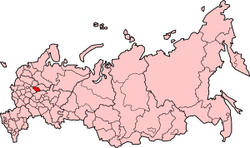Ivanovo
| Ivanovo Иваново | |||||
|---|---|---|---|---|---|
 Ivanovo city and streetcar | |||||
| |||||
| Position | |||||
 Position of Ivanovo in Russia | |||||
| Coordinate : 57°0'N 40°59'E / 57.000 degrees N 40.983 degrees E | |||||
| The history | |||||
| Documents appearance | 1561 | ||||
| Administration | |||||
| Country | |||||
| Federal district | Central Federal District | ||||
| Jurisdiction | |||||
| City | Ivanovo | ||||
| The mayor | Alexander Fomin | ||||
| Geography | |||||
| Area | |||||
| City limits | 104.8 km2 | ||||
| Altitude | 120 m | ||||
| Population | |||||
| Population | (as of 2008) | ||||
| City limits | 406,465 people | ||||
| Others | |||||
| Equal time obi | Moscow time (UTC +4) | ||||
| Zip code | 153000–153048 | ||||
| Area code | + 7 4932 | ||||
| Number plate | 37 | ||||
| An official web site: http://ivgoradm.ru/ | |||||
Ivanovo (Ivanovo, Russian :Ива́ново, Ivanovo) is a city of the Russian Federation. A state capital of Ivanovo. The population is a national census for 2,002 years; 431,721 people (in the 1989 national census 481,042).
It was located to northeast 300km of Moscow and was called "the capital of the Russian textile" traditionally. Because most of workers making a textile were women, there is the nickname called "the city of the bride", too. It is hometown of French literary person Nathalie Sarraute.
Table of contents
History
The name of the town of Ivanovo emerges for documents in 1561. In Ivanovo that was the village which made a textile from flax formerly, it was with a commercial city in the 17th century, and a textile mill was built in 1710 by Peter great emperor. Ivanovo pulls a Russian textile in the 19th century and reaches the florescence which is named Manchester, Russia. I was complicated with adjacent manufacturing town ヴォズネセンスキー ポサド (ВознесенскийПосад) in 1871 and changed my name with Ivanovo ヴォズネセンスク (I return an official name to Ivanovo in 1932).
In the early 20th century, Ivanovo developed competition visiting Polish textile industry city ウッチ (Russian Empire territory) and the European first fiber producing cities. However, the medium of the worker was inferior, and the strike was frequent, too. One of these strikes leads to the first revolution (1905) in Russia. A worker of Ivanovo made the Ivanovo Soviet Union (council, assembly by the worker) in May, 1905, but this is one of the Russian immediate early Soviet Union along with the Soviet Union of St. Petersburg.
Economy and culture
The main industry is the textile industry, but, besides, chemical industry and the machine industry are located now, too. The fiber business receives a blow after Soviet Union collapse, and the economy of prosperous Ivanovo of the fiber business is included in a severe class in Russia. In addition, there are Ivanovo State University, Ivanovo medical college, the Ivanovo state establishment electricity university, too. The "inter-dome" school where the children of the world Communist Party leader go to in 1933 of Soviet Union Era is built. [1]
An art museum and a museum are in Ivanovo and possess an icon and baroque art, modern art. In addition, a lot of buildings of constructionism architecture and the are nouveau stay, and the opera house of the city is a fine example of the constructionism architecture.
Sister city
Footnote
Outside link
This article is taken from the Japanese Wikipedia Ivanovo
This article is distributed by cc-by-sa or GFDL license in accordance with the provisions of Wikipedia.
In addition, Tranpedia is simply not responsible for any show is only by translating the writings of foreign licenses that are compatible with CC-BY-SA license information.


0 개의 댓글:
댓글 쓰기